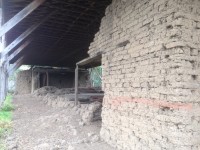Understanding the prehistory of any region includes addressing three primary goals. The first goal involves developing a chronology, the second is to reconstruct past lifeways, and the third is an attempt to explain culture change. In other words, how old is it, how did they do it, and what happened to make them try something else.
In well-developed prehistoric societies, where archaeological sites contain a wealth of material (artifacts), answering these questions can be relatively straight forward. Prehistoric archaeological sites in much of California often contain a limited variety of artifact types, making it difficult to address these three basic goals of archaeology.
Developing a chronology of events entails a variety of dating techniques to assist in determining when an event occurred. Without chronology, reconstruction of past lifeways and explaining culture change becomes difficult, if not impossible to address. Absolute dating determines the specific date for an archaeological site or artifact based on physical or chemical properties. Relative dating estimates the order of events generally based on stratigraphic principles.
Everyone wants to know how old a site is, and modern technology has come to the rescue. Carbon dating, obsidian hydration, lichenometry, and seriation are but a few techniques used by archaeologists.
Radiocarbon and obsidian hydration are two examples of absolute dating techniques. Radiocarbon dating is a method that uses carbonaceous material, such as bone, shell or wood, to determine the age of a site or artifact. The technique is destructive in that the material must be burned, thus many Native Americans frown upon this type of analysis. Obsidian is a volcanic glass used by prehistoric people to construct projectile points, knives and basic tools. Obsidian has an outer shell called cortex, which is removed during the manufacturing of tools. Once the cortex is removed, the obsidian begins to hydrate, slowly taking in water at a constant rate that can be measured. A hydration band forms and the thicker the band, the older the piece or site.
Lichenometry and seriation are examples of relative dating techniques. Lichenometry has been used to date surfaces such as gravestones and stone walls. The idea is that certain lichens grow at specific rates under specific conditions; rates that can be measured. Seriation is a method that places a collection of artifacts from a site into a chronological order. Seriation uses the principle of stratigraphy, the theory that older archaeological assemblages are represented at the bottom of a horizontal deposit, while younger assemblages were deposited at higher elevations.
Reconstructing past lifeways focuses on what, how and where. Those living in marine environments developed strategies for acquiring food very different than those living in interior settings. Coastal groups constructed boats, fish hooks, tailoring their lifestyles to the type of foods they desired. Those whose diet focused on big game had little use for fish hooks. Big game required the construction of large projectile points. Certain deductions can be made by the sheer number of specific artifacts. Flat ground stones are generally thought to be found in sites whose inhabitants relied heavily on seeds and nuts, which were ground into meal, whereas the round mortar and elongated pestle were more typically used by those pounding then grinding larger nuts such as acorns.
Through time, archaeologists see shifts in technology representing culture change. It is at this juncture archaeologists focus on the why. Were such changes based on environmental changes, shifting cultural ideologies, a combination of both? Environmental factors such as climatic change may have affected what plants and animals were available for daily use. The most dramatic example is the shift from constantly migrating groups in search of large Pleistocene animals (mastodon) to more sedentary lifestyles focused on developing methods for acquiring seafood.
The link between archaeology and adverbs? Adverbs often speak to when, what, how, where and why or under what conditions something happened. So, the next time you’re in the backyard gardening and you happen upon that beautifully decorated piece of ceramic, the odd looking marble or time sensitive square nail, don’t forget to ask. The answers may lead you down an unforgettable path of discovery.

